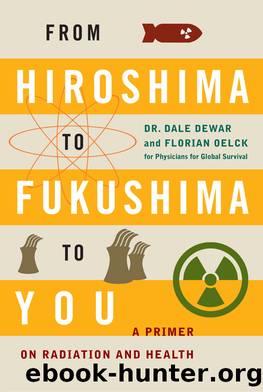From Hiroshima to Fukushima to You by Dale Dewar Florian Oelck

Author:Dale Dewar, Florian Oelck [Dale Dewar, Florian Oelck]
Language: eng
Format: epub
Tags: Social Science, Disease & Health Issues, Science, Radiation, Political Science, Public Policy, Environmental Policy
ISBN: 9781771131278
Google: y83SBAAAQBAJ
Barnesnoble:
Goodreads: 20312919
Publisher: Between the Lines
Published: 2014-05-15T00:00:00+00:00
CHAPTER 7
Uranium Mining
The Largest Release of Radioactivity in American History1
ON JULY 16, 1979, Robinson Kelly was getting ready for work in the small community of Church Rock in northeastern New Mexico. That morning, as always, he went to let the horses out of the coral and noticed an awful smell in the air. The little creek on the other side of the yard sounded much louder than usual. Indeed, the former creek had turned into a river, rushing with distinctly yellow-coloured water. There were no signs of rain. Kelly worked at the local uranium mine owned by the Kerr-McGee Corporation. At work, he learned that the Church Rock Dam, holding back tailings, had burst at the uranium mill. Approximately 1100 tonnes of radioactive milling waste and 356 million litres of radioactive waste water had poured into the Puerco River.
The Church Rock Dam disaster is not well known, yet the radiation released there was more than three times that of Three Mile Island (forty-six and thirteen curies,2 respectively). Uranium mining and mine tailings generally donât garner as much attention by the media, but, in this case, the low public interest and publicity surrounding the disaster was probably due to the fact that the population affected was largely rural, low-income, and Navajo. No research has been done on the health impact of the disaster on the local population. Robinson Kelly probably considers himself lucky to be alive. Both of his parents died of cancer and his uncle, who waded into the water to reach livestock and developed blisters and burns at the time, later succumbed to bone cancer in one foot. Kelly and many others continue to commemorate anniversaries of the spill. Meanwhile, the US Environmental Protection Agency and United Nuclear Corporation (operator of the mill and tailings ponds) continue to argue about clean-up and postpone responsibility.3
Mining and Milling
Uranium exists, concentrated in ore bodies, everywhere on Earth. It was present at âthe beginning of timeâ and is believed to be one of the primordial elements in the universe. It becomes profitable for mining at a concentration of 0.10 per cent uranium oxide (U3O8 ) or greater.4 Until 1954, all of the uranium mined in the world was used for nuclear weapons; that year, the Soviet Union (USSR) put the first electrical-producing nuclear power plant onto an electric grid at Obninsk, about one hundred kilometres southwest of Moscow, followed by the United Kingdom in 1956 at Windscale, Cumberland (now Sellafield, Cumbria), and the United States at Shipping-port, Pennsylvania (about forty kilometres from Pittsburgh) in 1957.5 Canada, Australia, and the Congo were the largest suppliers of uranium at that time. Today, the top producers of mined uranium are, in order of production, Kazakhstan, Canada, Australia, Niger, Russia, and Namibia.6
According to family doctors Linda Harvey and Cathy Vakil, writing for the Environmental Committee of the Ontario Chapter of the College of Family Physicians of Canada, âUranium mining is the messiest and most contaminating stage of nuclear power generation.â7 The three main ways to mine uranium are by open pit mining, underground mining, and in situ leach mining.
Download
This site does not store any files on its server. We only index and link to content provided by other sites. Please contact the content providers to delete copyright contents if any and email us, we'll remove relevant links or contents immediately.
Alchemy and Alchemists by C. J. S. Thompson(3448)
The Elements by Theodore Gray(2997)
The Club by A.L. Brooks(2862)
How to Make Your Own Soap by Sally Hornsey(2826)
Drugs Unlimited by Mike Power(2545)
Wheels of Life by Anodea Judith(2096)
Cracking the LSAT, 2012 Edition by Princeton Review(1880)
Cracking the Sat French Subject Test, 2013-2014 Edition by The Princeton Review(1828)
Perfume by Jean-Claude Ellena(1781)
The Flavor Matrix by James Briscione(1774)
The Cosmic Machine: The Science That Runs Our Universe and the Story Behind It by Scott Bembenek(1725)
MCAT Physics and Math Review by Princeton Review(1636)
1000 Multiple-Choice Questions in Organic Chemistry by Organic Chemistry Academy(1621)
The Thing Around Your Neck by Chimamanda Ngozi Adichie(1600)
Handbook of Modern Sensors by Jacob Fraden(1544)
Cracking the SAT Premium Edition with 6 Practice Tests, 2017 by Princeton Review(1535)
Synchrotron Light Sources and Free-Electron Lasers by Eberhard J. Jaeschke Shaukat Khan Jochen R. Schneider & Jerome B. Hastings(1524)
A is for Arsenic: The Poisons of Agatha Christie (Bloomsbury Sigma) by Kathryn Harkup(1507)
Harry Potter All Books: 8 Books by J.k.rowling(1492)
